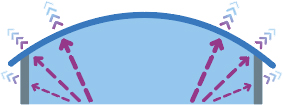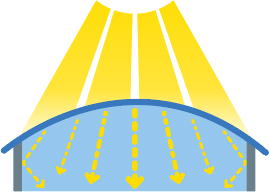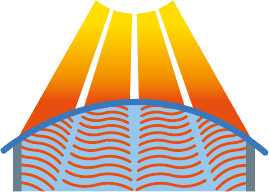

All the studies show that a well-designed daylighting solution has a very positive impact on a building's energy consumption. To measure the performance of a rooflight installation and calculate its energy balance, several parameters need to be considered, such as Effective Light Area (ELA), Natural Solar Heat Gain (or Solar Factor) and URC thermal conductance.

The ability of a rooflight to transfer heat is expressed as the "thermal conductance Urc" in W/m².K.
The thermal conductance coefficient Urc of a skylight designates the total heat flux that passes 1m² of wall, with a temperature differente of 1°C between its two faces (conductivity).
This thermal conductance Ur cis determined in relation to the external surface and calculated according to the instructions in Eurolux (in accordance EN 1873 and EN 14963).
The Urc value takes into account the following thermal conductivities:
Ut : Thermal conductance of filling (in W/m²K)
Ue : Thermal conductance of edge profile (in W/m²K)
Uup : Thermal conductance of upstand (in W/m²K)

Low heat loss
Thermal conductance
Urc (in W/m2.k)
The Uw coefficient is the value that characterises all losses through windows (w for window). The thermal transmittance of glazed walls, Uw, is calculated by weighting the thermal characteristics of the components by their corresponding surface areas or linear dimensions in relation to the total surface area of the wall, and is expressed in W/(m².K.).
The installed Urc coefficient is calculated by considering the installation of the upstand in the roof complex. According to the Eurolux guide, it is up to the design office to consider the proportion of upstand integrated into the roof insulation and the nominal dimensions of the rooflight in the roof - based on the characteristics of the rooflight provided by the manufacturer.
|
CALCULATE MY URC AND AIR PERMEABILITY WITH THE SKYDÔME CALCULATOR! |
The overall light transfer efficiency of a point or continuous skylight is characterised by the Effective Light Area (ELA).
Using the same principle as that used in smoke extraction to calculate the number of CFLs to be installed, the ELA is used to determine the number of skylights to be installed to obtain a given Daylight Factor, based on the useful opening area Aa:
Building surface area x Building transfer coefficient
x Daylight Factor
= SLE x number of skylights
The Effective Lighting Area (ELA) is calculated in m² according to the GIF method (a trade association that brings together manufacturers of spotlights and skylights), which is based on a study carried out by Ingelux (a lighting design office).

Zenithal lighting
Effective Lighting Area
ELA (inm²)
The energy balance of a rooflight is also based on its ability to transmit free solar heat gain to the interior of the building, an index characterised by the solar factor (g coefficient). This coefficient (in %) defines the proportion of thermal radiation that is transmitted through the skylight.

Natural solar heat gain
Solar factor
G (in %)